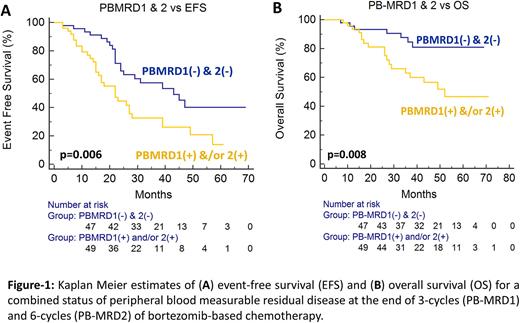Abstract
Introduction: Circulating clonal plasma cells (CCPC) reflect tumor burden in newly-diagnosed multiple myeloma (NDMM). There is a growing interest in investigating the clinical impact of CCPC quantitation due to its easy access and non-invasive nature. Recent studies have highlighted the value of quantification of CCPC at diagnosis for risk stratification of transplant-eligible MM. However, prospective data on the real-world utility of CCPC quantitation in MM patients treated without an autologous transplant due to limited resources or transplant ineligibility is extremely scarce. Additionally, there is no data on the clinical relevance of peripheral blood measurable residual disease assessment (PB-MRD) in NDMM treated without a transplant.
Aims: To investigate the prognostic value of CCPC quantitation in NDMM treated without a transplant using high-sensitivity multicolor-flowcytometry (HS-MFC). Further, we aimed to study the relevance of PB-MRD assessment in predicting event-free survival (EFS) and overall survival (OS).
Methods: We prospectively enrolled 141 NDMM patients (age: median-55 years; range-27-81 years; M:F-2). CCPC levels were studied using 10-13 color HS-MFC (sensitivity- 0.0001% or 1x10e-6) at diagnosis, at the end of 3-cycles (PBMRD1) and 6-cycles (PBMRD2) of chemotherapy. CCPC levels were calculated as CCPC percentages in total WBCs (%CCPC/WBC). BM-CPC was studied at diagnosis using MFC but BM-MRD was not studied as CR was achieved only in a small fraction of patients. The cut-off values were identified using ROC analysis against EFS. Patients received a bortezomib-based induction (VCD-98/141 & VRD-43/141) followed by consolidation chemotherapy. Initial therapeutic response (ITR) was monitored at the end of 6-cycles of chemotherapy. Detectable PBMRD was defined with ≥0.0001% CPCs.
Results: The median follow-up was 35 months (1-71 months). ITR included CR-7.1%, VGPR-43.97%, PR-33.33%, SD-2.84%, PD-2.84% and 14 (9.9%) patients died during initial therapy. CCPCs were detected in 108/141 (76.6%) patients. Median %CCPC/WBC was 0.024% (range, 0.00012-4.1%). BM-CPCs were detected in 134/141 (95%) patients with a median of 97.8% (range, 1.5-100%). ROC-based cut-offs for %CCPC/WBC and BM-CPC were ≥0.01% CCPC in WBC and >90% CPC in BM-total plasma cells (TPC) respectively. %CCPC/WBC ≥0.01% was strongly associated with EFS (22 vs. 50 months; HR-2.50; p<0.0001) and OS (52 months vs. not-reached; HR-2.28; p=0.01). High-risk (HR) cytogenetics, R-ISS, and BM-CPC>90% in TPC were significantly associated with EFS and high-LDH and R-ISS were significantly associated with OS on univariate analysis. %CCPC/WBC ≥0.01% was independently associated with EFS (HR-1.8, p=0.033) and OS (HR-2.2, p=0.018) on multivariate analysis.
PBMRD was performed in 108 patients with detectable CCPC at diagnosis. PBMRD1 was available in 98/108 and was detectable (median-0.002%; range-0.0001-2.5%) in 43/98 (43.9%) patients. PB-MRD2 was available in 96/108 and was detectable (median-0.001%; range-0.0001-1.45%) in 33/96(34.4%). Detectable PB-MRD1 was strongly associated with EFS (18 vs. 43 months; HR-2.23; p=0.0017) and OS (42 months vs. not-reached; HR-2.16; p=0.039). Similarly, detectable PB-MRD2 was associated with EFS (22 vs. 39 months; HR-2.11; p=0.005) and OS (43 months vs. not-reached; HR-3.77; p=0.0004). Notably, PBMRD negative status at any timepoint (PBMRD1 or PBMRD2) was independently associated with better EFS (22 vs. 43 months; HR-0.47; p=0.006). PBMRD persistence at the second timepoint (PBMRD2) was strongly associated with poor OS (52 months vs. not-reached; HR-3.03; p=0.008). PBMRD and HR-cytogenetics were independently associated with EFS and OS and found superior to serum immunofixation (sIF), ISS, R-ISS and LDH levels on multivariate analysis.
Conclusion: This prospective study showed that CCPC quantification (≥0.01% of WBC) at diagnosis provides a powerful prognostic factor for NDMM patients treated without an autologous transplant. PB-MRD assessment using HS-MFC is feasible and provides an independent biomarker for the prediction of EFS and OS. Early PB-MRD clearance predicts better EFS and persistence of PB MRD predicts poor OS. Our data indicated that CCPC, and PBMRD assessment using HS-MFC are superior to ISS, R-ISS, sIF and LDH. Such assessment is more convenient for routine clinical practice and should be confirmed in larger studies.
Disclosures
No relevant conflicts of interest to declare.
Author notes
Asterisk with author names denotes non-ASH members.


This feature is available to Subscribers Only
Sign In or Create an Account Close Modal